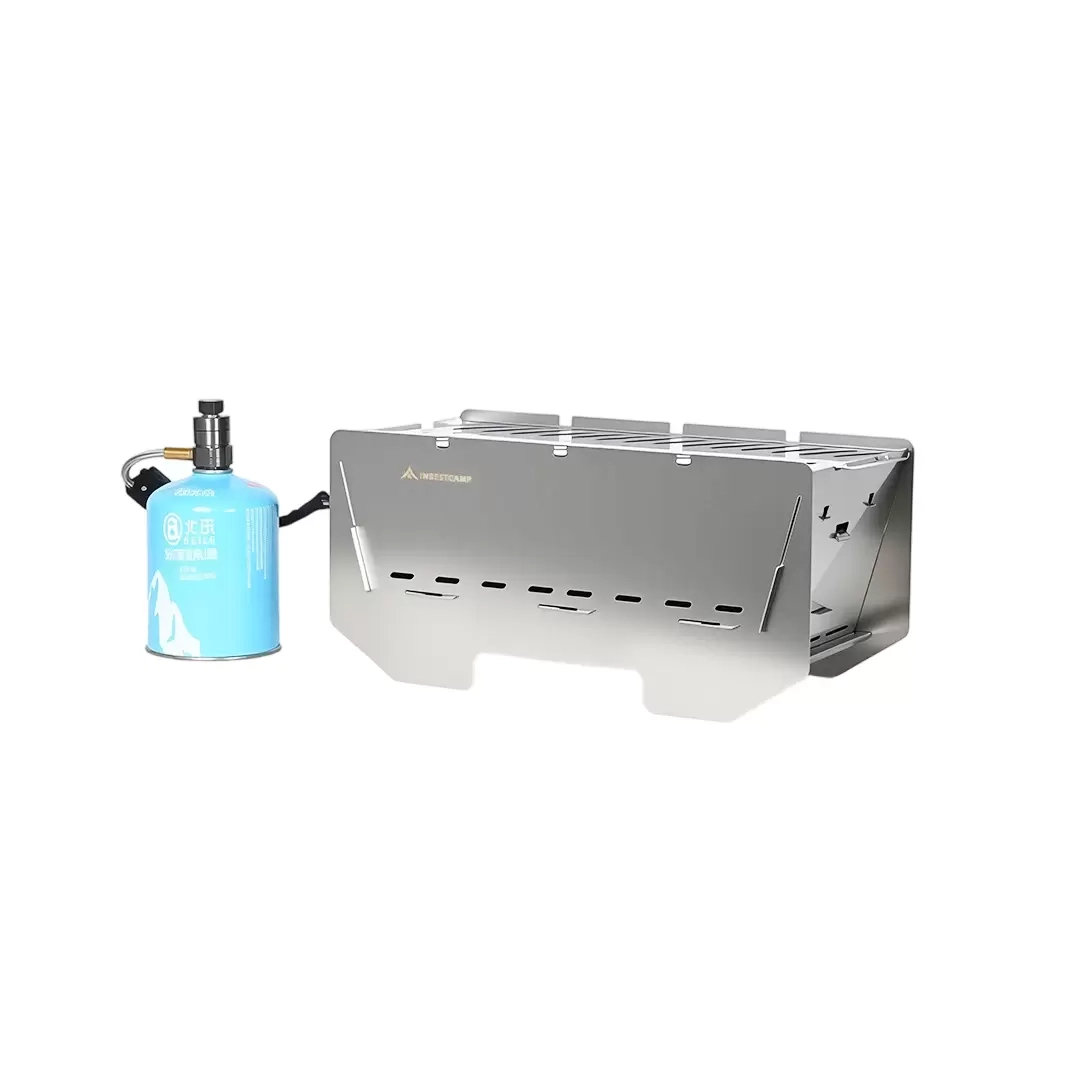Find out more about our news >
Exploring Heat Distribution in Commercial-Grade Camping Grills
When exploring commercial-grade camping grills, one of the most critical factors impacting cooking performance is heat distribution. Unlike casual backyard grills, commercial-grade grills demand precise thermal management to ensure uniform cooking, fuel efficiency, and durability under extreme outdoor conditions. At Tuoshenghe, we leverage over 15 years of vertical manufacturing experience to engineer grills that deliver unparalleled heat performance in diverse environments, from mountain expeditions to beachfront gatherings.
Heat distribution in a camping grill directly affects the cooking outcome, fuel consumption, and user experience. A poorly distributed heat source results in hotspots, undercooked food, and wasted fuel. Therefore, understanding and optimizing heat flow is essential for outdoor chefs, outdoor brands, and professional adventurers alike.
1. Material Selection and Thermal Conductivity
Commercial-grade camping grills rely heavily on material science to manage heat effectively. Tuoshenghe selects high-grade stainless steel alloys and cast iron components for our grills to maximize thermal conductivity while maintaining structural integrity. These materials balance:
Rapid heat-up: Stainless steel and cast iron efficiently absorb and transfer heat to the cooking surface, reducing preheat times for portable grills like our INBESTCAMP Gas Grill, which reaches 200°C in just three minutes.
Heat retention: Even in windy or cold environments, thick steel plates maintain temperature consistency, critical for wood-fired or multi-fuel grills.
Durability: Corrosion-resistant materials ensure longevity, even with frequent exposure to outdoor moisture, smoke, and temperature fluctuations.
By precisely controlling the alloy composition and plate thickness, Tuoshenghe ensures consistent heat across the grilling surface, preventing cold zones and promoting uniform cooking.
2. Burner Design and Placement
Commercial-grade grills achieve even heat distribution not only through material but also through burner architecture. Tuoshenghe’s grills integrate intelligent burner systems tailored to each fuel type:
Gas grills: Linear and circular burners provide uniform flame coverage. Strategic placement reduces hotspots, ensuring a balanced temperature gradient across the cooking surface.
Multi-fuel stoves: Wood, charcoal, and alcohol fuel options require adaptive airflow and heat chamber design. Adjustable vents and multi-layered burner plates control combustion and thermal dispersion.
Smokeless fire pits and pizza ovens: Innovative secondary combustion technology ensures that flame energy is redirected and recirculated, minimizing smoke while maximizing heat output.
Advanced burner configurations allow for controlled heat zones, enabling chefs to simultaneously sear, slow-cook, and maintain food at optimal temperatures on the same grill surface.

3. Airflow and Convection Management
Airflow management is a cornerstone of efficient heat distribution. Tuoshenghe implements precision-engineered venting systems to direct oxygen flow precisely into combustion chambers. Key innovations include:
Circular flame design in tent heaters: Maintains steady temperature even in winds exceeding force 7, demonstrating how airflow affects consistent heat distribution.
Vented multi-fuel chambers: Facilitate secondary combustion while evenly circulating heat to the cooking surface.
Optimized grilling grids: Elevation and spacing of grill bars allow natural convection to distribute heat evenly across all food items, eliminating cold pockets and ensuring uniform cooking.
Controlled airflow not only improves thermal efficiency but also reduces fuel consumption, extending the operational time for portable grills during long outdoor trips.
4. Thermal Mapping and Simulation in Production
At Tuoshenghe, our intelligent manufacturing process leverages thermal mapping and simulation software to design commercial-grade grills with consistent heat distribution:
3D thermal modeling identifies potential hotspots and cold zones during the R&D phase.
Laser-cut components are optimized for thickness and spacing, ensuring uniform temperature transfer.
CNC and robotic welding guarantee precise alignment of burners, heat plates, and ventilation, translating digital designs into physical grills with minimal deviation.
This approach ensures that every unit leaving our 5,000㎡ factory meets strict thermal performance standards and delivers predictable results in field conditions.
5. Heat Distribution Strategies for Different Fuel Types
Gas Grills
Gas grills provide immediate heat control but require careful burner calibration. Tuoshenghe’s portable gas grills feature single-ignition systems and multi-point flame arrays to achieve uniform cooking zones. The gas valve system allows fine-tuning of flame intensity, optimizing heat across the grill surface without overshooting temperatures.
Charcoal and Wood-Fired Grills
Heat management in solid-fuel grills relies on fire bed positioning and secondary heat reflectors:
Charcoal is arranged to create zones of varying intensity for searing or slow cooking.
Reflective steel panels redirect radiant heat upward, balancing temperature across wider grill surfaces.
Chimney vents and adjustable airflow controls enable precise modulation of combustion, improving fuel efficiency.
Multi-Fuel Stoves
Multi-fuel designs require hybrid strategies combining conduction, convection, and radiation. Tuoshenghe’s patented combustion chambers maintain heat equilibrium regardless of fuel source, allowing chefs to switch between wood, charcoal, or alcohol without compromising performance.
6. Environmental Considerations and Heat Stability
Outdoor cooking environments present unique challenges to heat distribution:
Wind resistance: Grills are designed with side shields and airflow channels to protect flames from wind-induced cooling.
Altitude variation: Reduced oxygen levels at high altitudes affect combustion efficiency. Tuoshenghe grills include adjustable vents and high-efficiency burners to maintain consistent heat in elevations up to 4,000 meters.
Temperature extremes: Insulated cooking surfaces and heat-reflective coatings ensure stable grilling temperatures even in sub-zero conditions.
These design strategies ensure commercial-grade camping grills perform reliably in diverse outdoor settings.
7. Heat Efficiency Metrics and Testing
Every Tuoshenghe grill undergoes rigorous thermal performance testing:
Temperature uniformity assessment: 3D heat sensors measure surface temperature across the entire grill, ensuring deviation remains within ±5°C.
Fuel consumption evaluation: Determines optimal heat-to-fuel ratio for extended grilling sessions.
Load-bearing and endurance testing: Guarantees that thermal cycles do not deform the structure or compromise heat distribution over time.
These metrics allow us to quantify the efficiency and reliability of our commercial-grade camping grills, providing B2B clients with data-driven confidence.

8. Integration with Portable and Smart Outdoor Solutions
Heat distribution is not isolated from the broader outdoor cooking ecosystem. Tuoshenghe integrates grill design with portable kitchen setups:
Snap-on tent heating systems convert a grill into a heating module, creating controlled environments for cooking and warming simultaneously.
Compact, lightweight grills (e.g., 2 kg portable gas grills) maintain rapid heat response, allowing heat to be directed precisely where needed.
Modular grill components allow users to stack or reposition burners to customize cooking zones.
This system-level approach ensures heat distribution is optimized not only within the grill but across the entire outdoor cooking and heating environment.
9. Optimizing User Experience with Heat Control
Even the best heat distribution system is only valuable if users can leverage it effectively:
Intuitive control knobs and real-time temperature indicators allow chefs to adjust heat zones quickly.
Predefined grilling grids and inserts are designed to match natural heat gradients, enabling even cooking without constant monitoring.
Compact design with efficient heat retention ensures that small portable units perform as well as larger stationary grills in professional settings.
10. FAQ Section
Q1: How do Tuoshenghe grills ensure even cooking across the entire surface?
A1: Through a combination of precision-engineered burners, conductive materials, airflow management, and thermal mapping, Tuoshenghe grills maintain uniform heat distribution, eliminating hotspots and cold zones.
Q2: Can the grills handle multiple fuel types without affecting heat consistency?
A2: Yes. Our patented multi-fuel combustion chambers are designed to stabilize heat output regardless of whether the fuel is gas, charcoal, or wood.
Q3: Are these grills suitable for extreme outdoor conditions?
A3: Absolutely. Designs incorporate wind-resistant flame systems, high-altitude adjustments, and heat-reflective coatings to maintain stable cooking temperatures in challenging environments.
Q4: How is fuel efficiency maintained without compromising heat distribution?
A4: Through precise airflow control, reflective heat panels, and optimized burner configurations, fuel is burned more completely, delivering consistent heat while minimizing waste.
Q5: Can these commercial-grade grills integrate with portable shelters or heating systems?
A5: Yes. Modular and snap-on systems allow grills to serve as both cooking and heating solutions, creating mobile kitchens with minimal weight and setup time.
Conclusion
Effective heat distribution is the backbone of commercial-grade camping grills. At INBESTCAMP, we combine precision manufacturing, patented thermal technologies, and industry-tested designs to ensure that every grill delivers consistent, reliable, and fuel-efficient heat. Whether your operation is a high-end outdoor catering service, adventure tourism, or retail outdoor brand, understanding and optimizing heat distribution in your grilling solutions is critical for achieving professional results in any environment.
By leveraging 15 years of vertical manufacturing, ISO-certified processes, and global service infrastructure, Tuoshenghe ensures that every unit shipped to more than 30 countries meets rigorous performance standards. Our approach to heat management not only maximizes cooking performance but also reinforces the reputation of INBESTCAMP as a trusted partner for outdoor cooking and camping equipment innovation.




 RELATED MAGAZINE
RELATED MAGAZINE 











